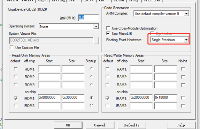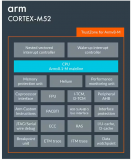在前一節(jié)課《源文件(.c/.h/.s)》里,痞子衡給大家系統(tǒng)地介紹了 source 文件,source 文件是嵌入式工程里典型的 input 文件,那么還有沒有其他類型的 input 文件?既然痞子衡這么提問了,那答案肯定是有啦。今天痞子衡要講的 linker 文件就屬于另一種 input 文件。
linker 文件顧名思義就是嵌入式工程在鏈接階段所要用到的文件,source 文件在編譯過程完成之后(此時(shí)已經(jīng)是機(jī)器可識別的二進(jìn)制機(jī)器碼數(shù)據(jù)),需要再經(jīng)過鏈接器從而將二進(jìn)制數(shù)據(jù)有序組織起來形成最終的二進(jìn)制可執(zhí)行文件,該二進(jìn)制文件最終會被下載進(jìn)芯片內(nèi)部非易失性存儲器里。linker 文件就是用來指示鏈接器如何組織編譯生成的二進(jìn)制數(shù)據(jù)。
linker 文件是跟 IDE 息息相關(guān)的,本文以 IAR EWARM 為例介紹 linker 文件,其他 IDE 下的 linker 文件可觸類旁通。
一、 嵌入式系統(tǒng)中的 section
在講 linker 文件之前,痞子衡必須先跟大家理清一個(gè)嵌入式系統(tǒng)中很重要的概念 -section。那么什么是 section?我們寫的 C 或者匯編 source 文件里都是各種應(yīng)用代碼,這些代碼按功能可以分為很多種類,比如常量、變量、函數(shù)、堆棧等,而相同類型的代碼的集合便是一個(gè) section,鏈接器在鏈接時(shí)組織數(shù)據(jù)的基本單元便是 section。那么一個(gè)典型的嵌入式系統(tǒng)中到底有多少種 section 呢?下面列出了 IAR 里默認(rèn)的所有 section,那些常見 section 在后續(xù)介紹 linker 文件里會被提到。
// 常見 Section
.bss // Holds zero-initialized static and global variables.
CSTACK // Holds the stack used by C or C++ programs.
.data // Holds static and global initialized variables.
.data_init // Holds initial values for .data sections when the linker directive initialize is used.
HEAP // Holds the heap used for dynamically allocated data.
.intvec // Holds the reset vector table
.noinit // Holds __no_init static and global variables.
.rodata // Holds constant data.
.text // Holds the program code.
.textrw // Holds __ramfunc declared program code.
.textrw_init // Holds initializers for the .textrw declared section.
// 較冷僻 Section
.exc.text // Holds exception-related code.
__iar_tls.$$DATA // Holds initial values for TLS variables.
.iar.dynexit // Holds the atexit table.
.init_array // Holds a table of dynamic initialization functions.
IRQ_STACK // Holds the stack for interrupt requests, IRQ, and exceptions.
.preinit_array // Holds a table of dynamic initialization functions.
.prepreinit_array // Holds a table of dynamic initialization functions.
Veneer$$CMSE // Holds secure gateway veneers.
// 更冷僻 Section
.debug // Contains debug information in the DWARF format
.iar.debug // Contains supplemental debug information in an IAR format
.comment // Contains the tools and command lines used for building the file
.rel or .rela // Contains ELF relocation information
.symtab // Contains the symbol table for a file
.strtab // Contains the names of the symbol in the symbol table
.shstrtab // Contains the names of the sections.
Note:上述 section 的詳細(xì)解釋請查閱 IAR 軟件安裝目錄下 /IAR Systems/Embedded Workbench
xxx/arm/doc/EWARM_DevelopmentGuide.ENU.pdf 文檔里的 Section reference 一節(jié)。
二、解析 linker 文件
知道了 section 概念,那便可開始深入了解 linker 文件,什么是 linker 文件?linker 文件是按 IDE 規(guī)定的語法寫成的用于指示鏈接器分配各 section 在嵌入式系統(tǒng)存儲器中存放位置的文件。大家都知道嵌入式系統(tǒng)存儲器主要分為兩類:ROM(非易失性),RAM(易失性),所以相應(yīng)的這些 section 根據(jù)存放的存儲器位置不同也分為兩類屬性:readonly, readwrite。實(shí)際上 linker 文件的工作就是將 readonly section 放進(jìn) ROM,readwrite section 放進(jìn) RAM。
那么到底該如何編寫工程的 linker 文件呢?正如前面所言,linker 文件也是有語法的,而且這語法是由 IDE 指定的,所以必須要先掌握 IDE 制定的語法規(guī)則,linker 文件語法規(guī)則相對簡單,最常用的關(guān)鍵字就是如下 8 個(gè):
// 動詞類關(guān)鍵字
define // 定義各種空間范圍、長度
initialize // 設(shè)置 section 初始化方法
place in // 放置 section 于某 region 中(具體地址由鏈接器分配)
place at // 放置 section 于某絕對地址處
// 名詞類關(guān)鍵字
symbol // 各種空間范圍、長度的標(biāo)識
memory // 整個(gè) ARM 內(nèi)存空間的標(biāo)識
region // 在整個(gè) ARM 內(nèi)存空間中劃分某 region 空間的標(biāo)識
block // 多個(gè) section 的集合塊的標(biāo)識
Note:上述 linker 語法的詳細(xì)解釋請查閱 IAR 軟件安裝目錄下 /IAR Systems/Embedded Workbench
xxx/arm/doc/EWARM_DevelopmentGuide.ENU.pdf 文檔里的 The linker configuration file 一節(jié)。
到這里我們已經(jīng)可以開始愉快地寫 linker 文件了,是不是有點(diǎn)按捺不住了?來吧,只需要三步走,Let's do it。
此處假設(shè) MCU 物理空間為:ROM(0x0 - 0x1ffff)、RAM(0x10000000 - 0x1000ffff),痞子衡要寫的 linker 要求如下:
中斷向量表必須放置于 ROM 起始地址 0x0,且必須 256 字節(jié)對齊
STACK 大小為 8KB,HEAP 大小為 1KB,且必須 8 字節(jié)對齊
SATCK 必須放置在 RAM 起始地址 0x10000000
其余 section 放置在正確的 region 里,具體空間由鏈接器自動分配
2.1 定義物理空間
第一步我們先定義 3 塊互不重疊的空間 ROM_region、RAM_region、STACK_region,其中 ROM_region 對應(yīng)的是真實(shí)的 ROM 空間,RAM_region 和 STACK_region 組合成真實(shí)的 RAM 空間。
// 定義物理空間邊界
define symbol __ICFEDIT_region_ROM_start__ = 0x00000000;
define symbol __ICFEDIT_region_ROM_end__ = __ICFEDIT_region_ROM_start__ + (128*1024 - 1);
define symbol __ICFEDIT_region_RAM_start__ = 0x10000000;
define symbol __ICFEDIT_region_RAM_end__ = __ICFEDIT_region_RAM_start__ + (64*1024 - 1);
define symbol __ICFEDIT_intvec_start__ = __ICFEDIT_region_ROM_start__;
// 定義堆棧長度
define symbol __ICFEDIT_size_cstack__ = (8*1024);
define symbol __ICFEDIT_size_heap__ = (1*1024);
// 定義各 region 具體空間范圍
define memory mem with size = 4G;
define region ROM_region = mem:[from __ICFEDIT_region_ROM_start__ to __ICFEDIT_region_ROM_end__];
define region STACK_region = mem:[from __ICFEDIT_region_RAM_start__ to __ICFEDIT_region_RAM_start__ +
__ICFEDIT_size_cstack__ - 1];
define region RAM_region = mem:[from __ICFEDIT_region_RAM_start__ + __ICFEDIT_size_cstack__ to
__ICFEDIT_region_RAM_end__];
2.2 定義 section 集合
第二步是自定義 section 集合塊,細(xì)心的朋友可以看到右邊花括號里包含的都是上一節(jié)介紹的系統(tǒng)默認(rèn) section,我們會把具有相同屬性的 section 集合成到一個(gè) block 里,方便下一步的放置工作。
// 定義堆棧塊及其屬性
define block CSTACK with alignment = 8, size = __ICFEDIT_size_cstack__ { };
define block HEAP with alignment = 8, size = __ICFEDIT_size_heap__ { };
// 定義 section 集合塊
define block Vectors with alignment=256 { readonly section .intvec };
define block CodeRelocate { section .textrw_init };
define block CodeRelocateRam { section .textrw };
define block ApplicationFlash { readonly, block CodeRelocate };
define block ApplicationRam { readwrite, block CodeRelocateRam, block HEAP };
有朋友可能會疑問,為何要定義 CodeRelocate、CodeRelocateRam 這兩個(gè) block?按道理說這兩個(gè) block 對應(yīng)的 section 可以分別放進(jìn) ApplicationFlash 和 ApplicationRam,那為何多此一舉?仔細(xì)上過痞子衡前一節(jié)課 source 文件的朋友肯定就知道答案了,在那節(jié)課里介紹的 startup.c 文件里有一個(gè)叫 init_data_bss()的函數(shù),這個(gè)函數(shù)會完成初始化 CodeRelocateRam 塊的功能,它找尋的就是 CodeRelocate 段名字,這個(gè)名字比系統(tǒng)默認(rèn)的 textrw 名字看起來更清晰易懂。
2.3 安置 section 集合
第三步便是處理放置那些 section 集合塊了,在放置集合塊之前還有 initialize manually 語句,為什么會有這些語句?還是得結(jié)合前面提及的 startup.c 文件里的 init_data_bss()函數(shù)來說,這個(gè)函數(shù)是開發(fā)者自己實(shí)現(xiàn)的 data,bss 段的初始化,所以此處需要通知 IDE,你不需要再幫我做初始化工作了。
// 設(shè)置初始化方法
initialize manually { readwrite };
initialize manually { section .data};
initialize manually { section .textrw };
do not initialize { section .noinit };
// 放置 section 集合塊
place at start of ROM_region { block Vectors };
//place at address mem:__ICFEDIT_intvec_start__ { block Vectors };
place in ROM_region { block ApplicationFlash };
place in RAM_region { block ApplicationRam };
place in STACK_region { block CSTACK };
當(dāng)然如果你希望 IDE 幫你自動初始化 data,bss,textrw 段,那么可以用下面語句替換 initialize manually 語句。
initialize by copy { readwrite, section .textrw };
設(shè)置好初始化方法后,便是放置 section 集合塊了,放置方法主要有兩種,place in 和 place at,前者用于指定空間塊放置(不指定具體地址),后者是指定具體地址放置。
至此一個(gè)基本的 linker 文件便大功告成了,是不是 so easy?
番外一、自定義 section
有耐心看到這里的朋友,痞子衡必須得放個(gè)大招獎勵一下,前面講的都是怎么處理系統(tǒng)默認(rèn)段,那么有沒有可能在代碼里自定義段呢?想象一下你有這樣的需求,你需要在你的應(yīng)用里開辟一塊 1KB 的可更新的數(shù)據(jù)區(qū),你想把這個(gè)數(shù)據(jù)區(qū)指定到地址 0x18000 - 0x183ff 的范圍內(nèi),你需要在應(yīng)用里定義 4 Byte 的只讀 config block 常量指向這個(gè)可更新數(shù)據(jù)區(qū)首地址(這段 config block 只會被外部 debugger 或者 bootloader 更新),如何做到?
// C 文件中
/////////////////////////////////////////////////////
// 用@操作符指定變量 myConfigBlock[4]放進(jìn)自定義 .myBuffer section
const uint8_t myConfigBlock[4] @ ".myBuffer" = {0x00, 0x01, 0x02, 0x03};
// Linker 文件中
/////////////////////////////////////////////////////
// 自定義指定的 mySection_region,并把 .myBuffer 放到這個(gè) region
define region mySection_region = mem:[from 0x0x18000 to 0x183ff];
place at start of mySection_region { readonly section .myBuffer };
上面做到了將代碼中的常量放入自定義段?,那么怎么將代碼中的函數(shù)也放進(jìn)自定義段呢?繼續(xù)看下去
// C 文件中
/////////////////////////////////////////////////////
// 用#pragma location 指定函數(shù) myFunction()放進(jìn)自定義 .myTask section
#pragma location = ".myTask"
void myFunction(void)
{
__NOP();
}
// Linker 文件中
/////////////////////////////////////////////////////
// 把 .myTask 放到 mySection_region
place in mySection_region { readonly section .myTask };
看起來大功告成了,最后還有一個(gè)注意事項(xiàng),如果 myConfigBlock 在代碼中并未被引用,IDE 在鏈接的時(shí)候可能會忽略這個(gè)變量(IDE 認(rèn)為它沒用,所以優(yōu)化了),那么怎么讓 IDE 強(qiáng)制鏈接 myConfigBlock 呢?IAR 留了個(gè)后門,在 options->Linker->Input 選項(xiàng)卡中的 Keep symbols 輸入框里填入你想強(qiáng)制鏈接的對象名(注意是代碼中的對象名,而非 linker 文件中的自定義段名)即可。
Note:關(guān)于番外內(nèi)容的更多細(xì)節(jié)請查閱 IAR 軟件安裝目錄下 /IAR Systems/Embedded Workbench
xxx/arm/doc/EWARM_DevelopmentGuide.ENU.pdf 文檔里的 Pragma directives 一節(jié)。
至此,嵌入式開發(fā)里的 linker 文件痞子衡便介紹完畢了,掌聲在哪里~~~
審核編輯黃昊宇
-
嵌入式
+關(guān)注
關(guān)注
5068文章
19021瀏覽量
303361 -
Linker
+關(guān)注
關(guān)注
0文章
3瀏覽量
1648
發(fā)布評論請先 登錄
相關(guān)推薦
樹莓派Pico 2發(fā)布,搭載RP2350雙核RISC-V和Arm Cortex-M33微控制器!
使用Keil uVision對TLE9893_2QK Evalkit進(jìn)行編程,顯示\"未找到Cortex-M SW設(shè)備\",為什么?
stm32單片機(jī)學(xué)習(xí)路線
Cortex-M0+內(nèi)核介紹

如何調(diào)整二相步進(jìn)電機(jī)的步進(jìn)角度,控制步進(jìn)角度的功能?

Cortex-M3芯片有哪些
Cortex-M85內(nèi)核單片機(jī)如何快速上手

強(qiáng)大的Arm? Cortex?-M3內(nèi)核(下)

請問mbed物聯(lián)網(wǎng)操作系統(tǒng)會成為cortex-m中的android嗎?
如何使用Keil打開GD32 FPU及使用ARM DSP庫 ?

Arm Cortex-M52的主要特性和規(guī)格





 從文件角度,了解Cortex-M開發(fā)(二)
從文件角度,了解Cortex-M開發(fā)(二)










評論